Official Information
- Official Name: Jamaica
- Capital: Kingston
- Independence Day: August 6, 1962
- Nationality: Jamaican
- Official Language: English
- Total Population: 2.6 million
- National Flower: Lignum Vitae (Wood of Life)
- National Tree: Hibiscus elatus (Blue Mahoe)
- National Bird: Trochilus polytmus (Doctor Bird)
- National Dish: Ackee and saltfish
- Currency: $J (Jamaican Dollar)
Jamaican ICONS
-

While not indigenous to Jamaica, the ackee has remarkable historic associations. It was originally imported from West Africa, probably on a slave ship. Ackee now grows luxuriously in Jamaica, producing large quantities of edible fruit annually. The tree was unknown to science until plants were taken from Jamaica to England in 1793 by none other than Captain William Bligh (of Mutiny on the Bounty fame) -- hence the botanical name Blighia sapida, in honour of the notorious sea captain. One of the earliest local propagators of the tree was Dr. Thomas Clarke, who introduced it to the eastern Jamaican parishes in 1778.Jamaica is the only place where the fruit is generally recognised as an edible crop, although the plant has been introduced into most of the other Caribbean islands (and even Florida in the USA), but is not harvested for commercial production.
-

The Doctor Bird or Swallowtail Hummingbird (Trochilus polytmus) lives only in Jamaica and is one of the most outstanding of the 320 species of hummingbirds. It is interesting to note that the beautiful feathers of this bird have no counterpart in the entire bird population and produce iridescent colours characteristic only of that family. The Doctor Bird has been immortalised for many decades in Jamaican folklore and song.
-

The Blue Mahoe (Hibiscus elatus) has been regarded as one of Jamaica's primary economic timbers. It is currently used for re-afforestation and is a valuable source of cabinet timber. Of an attractive blue-green colour with veriegated yellow intrusions, it is capable of taking a high polish, showing the variety of grain and colour tones. The trade, local and foreign, consumes many thousands of feet of this beautiful timber every year.
-

Lignum Vitae (Guiacum officinale) is indigenous to Jamaica. It is thought that the name "Wood of Life" was originally adopted because of the plant's medicinal qualities. The tree grows best in the dry woodlands along both the North and South Coasts of the island, and is a very ornamental plant. The wood is used for propeller shaft bearings, curios, and there is a thriving export trade.
-

The Jamaican flag came into use on August 6, 1962, Jamaica's Independence Day. It was designed by a bipartisan committee of the Jamaica House of Representatives. The flag has a diagonal cross (or saltire) with four triangles in juxtaposition. The diagonal cross is in gold, and equals one-sixth of the length of the fly of the flag; the top and bottom triangles are green; and the hoist and fly triangles are black. The exact shade of green used in the flag is Emerald T8 17, British Admiralty Bunting Pattern. The flag follows the Admiralty Pattern, and the proportion is 2:1.The flag is symbolised by the motto "Hardships there are but the land is green and the sun shineth." The black stands for hardships overcome and to be faced; the gold is for natural wealth and beauty of sunlight; and the green symbolises hope and agricultural resources.
-

The original Coat of Arms granted to Jamaica in 1661 was designed by the Archbishop of Canterbury, William Sandcroft. Apart from a partial revision in 1957, it remains virtually the same as was originally designed. The Coat of Arms shows a male and female Arawak Indian, standing on either side of the shield, which bears a red cross with five golden pineapples. The Crest is a Jamaican crocodile atop the Royal Helmet and Mantlings. The original Latin motto "Indus Uterque Serviet Uni" has been changed to one in English: "Out of Many, One People."
Jamaica’s history is simultaneously colorful, intriguing and dark. It is full of stories about pirates, European dominators, Africans and native inhabitants.
The country was first populated by Arawak Indians (which quickly became extinct after the arrival of the Spanish. Today, some 3,000 or so Arawaks exist only on the island of Dominica).
On his second trip to the New World, Christopher Columbus landed at Discovery Bay in 1494 and reportedly described the island as “the fairest land my eyes have ever seen.” The name he originally gave the island was St. Jago, after the patron saint of Spain. The word Jamaica eventually replaced St. Jago and is fittingly adapted from the Arawak word, “Xaymaca,” which means “land of wood and water.”
Columbus was marooned for a brief period on the island in 1503. Ultimately, Columbus’ son settled in Jamaica in 1509. In 1536, the Spanish King deeded the entire island to the Columbus family. It remained a private domain until the 1620s when Spain reclaimed it. The official reason given to this takeover was that there was religious heresy in Jamaica. The real reason, however, was that settlers wanted title to their land—which the Columbus family refused. The conspiracy, with its accompanying intrigue, produced the desired result. Besides, Spain had also come to realize that the island had tremendous economic potential—particularly from the sale of cow and pig fat from Bahia de Marteca (Montego Bay, the Bay of Lard). Today, the only remaining reference to either Columbus or his heirs is a persistent tale of a secret (yet lost) gold mine located by the first explorer. Legend has it that the location of the mine is somewhere in a largely unpopulated and isolated area along the border between St. Ann and St. Mary parishes.
Jamaica’s first European settlement was called Seville Nueva, located near St. Ann’s Bay. The town was abandoned in 1538 and moved to Spanish Town on the south coast—which became the capital. Seville Nueva is now extinct.
During a war the British captured Jamaica in 1655 and soon turned the island into a vast sugar cane empire. Africans were imported as slaves to work the huge plantations. Slavery ended in 1838 and Indians and Chinese were imported as cane workers, along with German workers—some of whom are still living descendants of this original group.
When England conquered Jamaica many of the Spanish slaves fled to the interior of the country. These people became known as Maroons—a word adapted from the word “cimarron” or cima—meaning mountain top, because of where the ex-slaves resided. Maroons still reside in the region and are allowed a certain element of self-governance.
About 90% of present day Jamaica’s population is African by descent; however, one hears “patois” spoken—a blend of Spanish, French, English and African dialects. A frequently heard word is “Irie” (everything is fine, cool, okay); another is “boondondonoos” (best or delightful).
A hard to miss sight is the presence of Rastafarians—distinguished by dreadlock hair styles (copied from the former Ethiopian leader, Haile Selassie). Their message speaks of world peace, brotherly love and unification.
Jamaica comprises 4,411 square miles and is divided into 3 counties and 14 parishes. It is 146 miles long and varies between 22 and 51 miles in width. It has some 120 rivers and the annual rainfall is 78 inches. About half of the island is above 1000 feet, with the highest point being Blue Mountain at 7,402 feet.
Like many cultures, the first Jamaicans, the Taino Indians, used the barter system trading commodities for other commodities. Although there was some gold on the island, the Tainos used it for decorative purposes. When the Spanish arrived in the 1490s and began to trade with the Tainos, they tended to use glass beads and other trinkets. By the early 1500s coins were in use on the island. They were very thin and light, made from copper and called maravedis. More

